The new inscriptions found at the Buddha image in Ubosot Wat Chedi Luang Voravihara Chiang Mai: art styles and historical interpretations
Main Article Content
Abstract
This academic article aims to present new evidence, an unpublished inscription found at the base of the Buddha image in the Ubosot of Wat Chedi Luang, Chiang Mai province. The Buddha image has been plastered over several times in different eras. After the plaster was removed, inscriptions were found at the base. In this article, the author aims to present: 1. Meaning of the inscriptions. 2. The form of the Buddha image and its age compared to the inscriptions. 3. The historical significance and interpretation in the context of Lanna history, and the importance of all inscriptions. It was found that the script appearing is Lanna script from the 22nd Buddhist century, with significant content stating that in the year 949 BE (2130 BC), a person named "Panyaraksa" along with family and relatives became the external president (lay committee) while internally (monk committee), there were Phra Maha Somdet of Wat Phra Singh, Phra Ratcha Wanit of Wat Suan Dok, and Phra Ratcha Wanit of Wat Jetiyalung. The discovery of this main inscription, when studied under various perspectives and contexts, provides an understanding of the worldview and society of Lanna during the early period of Myanmar rule. It was found that Myanmar only changed the governing system, while customs and culture continued from the late Lanna period, as before
Article Details

This work is licensed under a Creative Commons Attribution-NonCommercial-NoDerivatives 4.0 International License.
References
คณะสังคมศาสตร์ มหาวิทยาลัยเชียงใหม่. (2518). รายชื่อวัดและนิกายสงฆ์โบราณในเชียงใหม่ ภาคปริวรรต ลำดับที่ 7. เชียงใหม่: มหาวิทยาลัยเชียงใหม่.
คณะอนุกรรมการตรวจสอบและชำระตำนานพื้นเมืองเชียงใหม่. (2538). ตำนานพื้นเมืองเชียงใหม่ ฉบับ 700 ปี. เชียงใหม่: สถาบันราชภัฏเชียงใหม่.
ธนจรรย์ สุรมณี และคณะ. (2539). เกร็ดประวัติวัดเจดีย์หลวง ฉบับบสมโภชเชียงใหม่ 700 ปี. เชียงใหม่: กลางเวียงการพิมพ์.
ประเสริฐ ณ นคร และปวงคำ ตุ้ยเขียว. (2562). ตำนานมูลศาสนาเชียงใหม่ เชียงตุง. กรุงเทพฯ: สมาคมประวัติศาสตร์ในพระราชูปถัมภ์สมเด็จพระเทพรัตนราชสุดาฯ สยามบรมราชกุมารี.
พงษ์ระวี โหลิมชยโชติกุล. (2566). “อิทธิพลพุทธศาสนาลังกาวงศ์ที่ปรากฏในงานพุทธศิลปกรรมล้านนา.” วิทยานิพนธ์ปรัชญาดุษฎีบัณฑิต บัณฑิตวิทยาลัย มหาวิทยาลัยมหามกุฎราชวิทยาลัย.
พระรตนปัญญามหาเถระ และแสง มนวิทูร, ผู้แปล. (2501). ชินกาลมาลีปกรณ์. กรุงเทพฯ: กรมศิลปากร.
ศักดิ์ชัย สายสิงห์. (2551). ศิลปะเมืองเชียงแสน. กรุงเทพฯ: คณะโบราณคดี มหาวิทยาลัยศิลปากร.
ศักดิ์ชัย สายสิงห์. (2556). พระพุทธรูปในประเทศไทย: รูปแบบ พัฒนาการและความเชื่อของคนไทย. กรุงเทพฯ: คณะโบราณคดี มหาวิทยาลัยศิลปากร.
สงวน โชติสุขรัตน์. (2556). ประชุมตำนานล้านนาไทย. พิมพ์ครั้งที่ 2. กรุงเทพฯ: ศรีปัญญา.
สรัสวดี อ๋องสกุล. (2566). ประวัติศาสตร์ล้านนา. พิมพ์ครั้งที่ 13. กรุงเทพฯ: อมรินทร์.
ฮันส์ เพนธ์. (2519). คำจารึกที่ฐานพระพุทธรูปในนครเชียงใหม่. กรุงเทพฯ: คณะกรรมการจัดพิมพ์เอกสารทางประวัติศาสตร์ สำนักนายกรัฐมนตรี.
ฮันส์ เพนธ์. (2547). ประวัติศาสตร์ล้านนาฉบับย่อ. เชียงใหม่: หอศิลปวัฒนธรรมจังหวัดเชียงใหม่ ซิลค์เวอร์ม.

